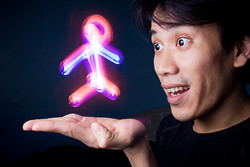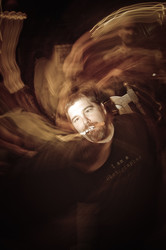Mid June 2007, one of my best friends was getting married in France. For his wedding day, I decided that I should give a try with flash photography for low light conditions. So I bought a Sigma EF-500 DG ST, an E-TTL only flash. Having no clue on how to properly use a Flash gun using E-TTL, I started to look for a good tutorial on the web. One of them was linking to a blog called Strobist. That was the start of an addiction. I couldn't stop reading that great blog that teaches you all you need to know about off-camera flash photography. My issue then was that my Sigma flashgun was E-TTL only and the blog is mentionning about using manual flash to have full control on your work. So after the wedding I sent the flashgun back to the shop for an exchange for the Sigma EF-500 DG Super which allows manual control of the flash.
November 2007, the EHHPS (a local photographic society here in Ealing) was organizing what they call "Panel of Prints Competition". As its name indicates it's a competition where you present a panel that has to be composed of at least 3 and up to 6 images that have to be linked by a same subject or that are telling a story. So one night, coming back from work on the bus, I was trying to think of what to shoot for this competition. It was the time where "painting with light" photographs was flourihing on the web. The idea was in my head for quite a while already, but I didn't want to do something that has already been done so many times and wanted to add something more to it: "what about mixing two techniques to it? A off-camera lit self-portrait and painting with light?". That sounds cool to me and few ideas started to grow as I nearly missed the bus stop....
When taking a portrait, the most important thing in your picture is the main subject. The background should be cool but the subject should be the main focus. You need to separate your subject from the background by, for example, narrowing the depth of field to blur it, restrict the flash light with a grid spot so it only light the subject and leave the background to the ambiance light or throw the background to some motion blur and maintaining the subject acceptably sharp.
This technique does not require you to own a fast lens (with great aperture), you don't even need a moving background, but you need to own an external flash gun triggered off-camera. It will help you make the background less obvious by bluring it in a stylish way and also create some special mood to the picture.










View comments (7)